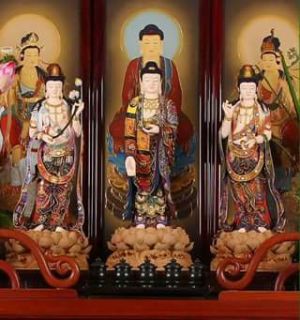Thoughts On The Nembutsu
Matthew Gindin
Recently, at times it would be good medicine, I’ve begun to sometimes chant the Nembutsu, a kind of mantra associated with Jodo Shu, a Japanese form of Pure Land Buddhism usually considered a form of devotional “folk Buddhism.” Sometimes I’ll chant it out loud, sometimes internally. Why would I do that? What is the Nembutsu?
In the hoary days of early Indian Mahayana, mythology abounded. The goal of spiritual practice shifted from the early focus on liberation here and now towards the amassing of virtues towards becoming a Buddha, which was now conceived as an immortal, magical being who lived forever in spontaneous service to all living beings.
The Buddhist spiritual path became one of asceticism, fasting, chanting, virtue and self-sacrifice, with teachers claiming it could take untold numbers of lives of practice to attain the goal. A multitude of reform movements would spring up from time to time to pull Buddhism back down to earth- Zen, Mahamudra, Dzogchen, Kammathana, Vipassana, and others.
In China an early solution to the sense of demand and distance that some streams of Mahayana created came in the form of Pure Land Buddhism. In this form of Buddhism, which was one of many similar streams- the extreme yoga of Mahayana was replaced by a relieving reliance on grace.
A powerful Buddha- Amitabha or Amida in Japanese, had vowed, while still a bodhisattva, that when he became a Buddha anyone who chanted his name would be reborn after death in his “pure land”- a realm generated by his mind. In that realm they would comfortably and easily complete the path to Buddhahood. Since Amida had in fact then become a Buddha, the fruit of his vow is believed to be certain due to a kind of cosmic legalism.
In Japan Shinran developed the Pure Land teaching by simplifying and popularizing this picture, emphasizing that no human being could actually attain Buddhahood under their own power (tariki) any more due to the degenerate state of the world, and that it is thus necessary to rely on grace or “other-power” (jariki). Literally all one has to do is chant Namo Amida Butsu (the “Nembutsu”) and one is saved by grace.
For centuries the Japanese school that follows these teachings (Jodo Shin Shu) has lived side by side, however, with a very different answer to the Mahayana question of how to become a Buddha- Zen.
Zen is all tariki (self-power) and relies on the realization, as Hakuin Zenji wrote, that “this very body is Buddha, and this very land the pure land.” Practice is realization, and one is already Buddha- one just doesn’t recognize it. Although one might think that Pure Land and Zen are thus at odds, in fact they have influenced each other and led to forms of fusion between the two, including one that inspires my occasional use of the Nembutsu.
Some Pure Land teachers came to point out that since they have already been saved by Amida, their chanting of the Nembutsu — the main practice in Pure Land Buddhism — is not in order to be saved but to acknowledge they are already saved. It is an expression of gratitude.
Riffing off of this Zen teachers pointed to the Nembutsu as a way to express gratitude for one’s Buddha nature, or the fact that really one is already free.This is the type of Nembutsu I like, and the reason I sometimes chant it- as a reminder.
It has lead me to a new translation for the Nembutsu:
“This is as good as it gets.”
We hear a lot in Zen about “ordinary mind is the way”, and “enlightenment is intimacy with all things.” Kodo Sawaki, a great 20th century teacher, said, “Not to clarify the Self is not to realize that you are Buddha as you are. That is blasphemy of the Self.”
Awareness is already free. Things are already unfolding effortlessly. There is nowhere special to go.
It doesn’t get any better than this.
When I chant the Nembutsu, I do it as a reminder and appreciation for the way things already are. A reminder to drop fantasies of “better” — the belief that things could be otherwise than they actually are.
A reminder that regardless of what training, self-improvement, or spiritual practice I might undertake, at the end of it there will just be this Here/Now (as Joan Tollifson calls it), this illuminating awareness, this impermanence, this one-thing-after-another.
Please note I’ve used the Japanese terms for Pure Land practice here, though the school started in China (as did Zen, originally called Chan).
Source
[[1]]
